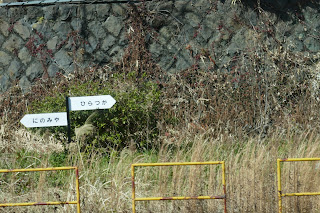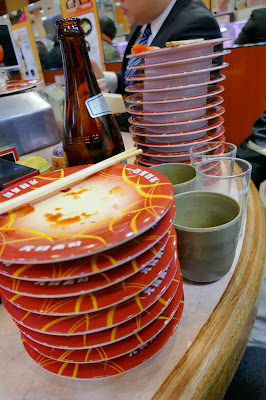 |
| First Shinkansen of the Trip |
So, for most of this year's travels, we've been planning a few days to a week or maybe 10 days in advance. We'll put some hard dates and locations in the excel spreadsheet (of course there is one!) for things where we actually need to be somewhere (flights, holidays, weddings, visits with friends, etc.) and then just fill in the blanks as it strikes our fancy.
Part of this is because in most of our travels, it's been impossible to know exactly how things will turn out, how long it will take us to accomplish what we think we'd like to do, and how the next step of travel will work, so it's just easier to go with the flow.
 |
| Hiking Fuji-san is totally a bucket list item (look at those switchbacks!) but not this trip. |
Japan is pretty much the opposite of the rest of the countries we've visited this trip with respect to ability to plan. Everything works here. Since we were still in Southeast Asia mode, we didn't get around to booking our flight to Tokyo from HCMC until about a week before we took it (but we've had our flight back to California since before the end of 2016).
So, about a week before we arrived, we finally knew we were flying in to Tokyo (we'd actually hoped to fly into Fukuoka, but we waited too long and the flights were too expensive), we knew we were leaving from Tokyo, and we knew we had 18 nights in between. We had no real idea where we were going, just some rough "that would be cool" inclinations. Folks, what I can tell you is that this is not how most foreigners "plan" their trips to Japan. For good reason.
 |
| One of infinite underground tunnels between train and metro stations. |
First, there's the JR pass. This is a very big expense, but if you use it wisely, it can save you quite a bit of money. We did not research the pass very much other than asking a friend what he recommended. He said to get the Green Car upgrade so we could just book day of and not have to worry about trains being sold out. So that was our plan. Green Car. In Bangkok, when we started to look into actually buying our passes (you supposedly can't buy them in Japan, but one of the vendors offered to ship to our hotel in Japan when they couldn't deliver to us in Vietnam, so I'm not sure how exactly that all works and/or is enforced). The JR passes come in many different configurations, some less expensive based on the regions where you would use it (which we didn't know yet) and the full country pass comes in 3 different time options: 7 days, 14 days, and 21 days.
 |
| So, speaking of speed and transport -- a mazda car won LeMans in 1991 (With a Wankel engine!) |
To get the most value out of the pass, you want to be using it on the high value legs, which, for obvious reasons, tend to involve the (almost but not quite fastest on the system, which are not included in the pass) super-fast Shinkansen that pass through the big cities, like Tokyo. This meant that we either had to spend 4 days in Tokyo on the ends and go with a 14 day pass in the middle (which would have been the most economical thing to do) or go with a 21 day pass and just acknowledge that we'd be missing out on 3 days of value because we wouldn't even be in the country. But, we've already spent quite a bit of time in Tokyo on previous trips. And, we really wanted to spend most of our time elsewhere. So, this is where I did something very much against my nature and advocated for the 21-day full-country pass, which was lazy because we were going full country only because we weren't sure where we were going, and would be quite wasteful and expensive with 3 throw-away days compared to the 14-day option.
 |
Ltd. Express Sonic Kyushu from Fukuoka to Beppu
Jetsons styled train
Rotate your own seats when the train changes direction
|
Mind you, at this point, we were still firmly in go-with-the-flow SE Asia. First, we had stereotypical chaos for the region trying to identify where and how to get the passes in Bangkok. Fine, we found an online provider who promised to ship in 2 days' time, so we placed the order and asked for them to be shipped to our hotel in HCMC. I emailed to confirm that it would arrive on time and finally got a vague response about Tet and how they couldn't guarantee it (even though the website offered a 2-business-day guarantee and Tet was, technically, over). Fine, we canceled the online order and went in person on a business day to a JTB authorized JR pass reseller in HCMC. The receptionist was there, but the rest of the staff were all off, having taken the rest of the week as holiday even though, technically, Tet was over in the middle of the week. Finally, the next Monday, we returned and successfully bought our pass vouchers, hours before we were to take the fast ferry to Long Hai.
 |
| Rainbow over Beppu Ferry Landing |
Please -- Learn from our mistakes -- research your route ahead of time, figure out what regions make the most sense to visit (and when), maximize the 7 day interval options so as not to leave days on your pass unused. And order your passes well in advance (the vouchers are good for 3 months, so in hindsight, I really should have managed this while we were in the US for the holidays, except, of course, I had no idea from where and when we'd be flying to Japan...)
 |
| Our final route (with a few additional stops between Nagoya and Tokyo, but more or less on the lines shown here). |
Anyways, there we were. We had vouchers for the whole country and 18 days to use them. We'd thought we might want to go visit Sapporo during the Snow Festival. But... by the time we got around to thinking about booking hotels everything within our price range was completely sold out. Okay, one decision made, we'd just stay off Hokkaido (the main North island).
After reading the guidebooks and considering our options, we decided to hit a few musts: Osaka, Hiroshima/Miyajima, Fukuoka/Kyushu (visit with my friend from Italian Language school), Shikoku, and a visit with my childhood exchange student, likely in Kamakura, as she loves it and we'd never been.
 |
| Totally snowing on our Shinkansen from Tokyo to Osaka. |
Osaka. I'd heard it was a great food city, that the people were warm and friendly, and that it was just a great place. So, we headed straight there on the highest value use of the pass this trip after one night in an airport hotel and an hour wait to exchange the vouchers for the JR pass at the Narita JR station. When we arrived it was so cold that even with my gloves and hat I wondered what the hell we were thinking with considering going north to Hokkaido -- it was snowing on our Shinkansen south to Osaka from Tokyo!
 |
| Sunset from Miyajima. |
We proceeded along our loose route, booking as far in advance as I thought was reasonable, but each time we kept getting screwed by finding decent rates 4-7 days in advance, only to try to book 2-3 days in advance and find everything gone or much more expensive. Lesson: Don't take your SE Asian (or South American) travel norms with you to Japan -- do some advance planning. You do not have to worry about whether you will get to where you are planning to go on time. You Will Arrive On Time!
 |
| One of a million photos of Miyajima Torii. |
We maximized the JR pass the best we could and in the end, we essentially broke even. The optimizer in me was dying to construct an itinerary that would have saved much more money, but that was not to be on this trip. We paid $739 for the 21 day pass and when we're done, we'll have taken JR shinkansen, local rail, and metros that totaled roughly the same amount if we'd been in 2nd class. The big differences were:
1) we were always in the Green Car, which means we always had 2X2 seating (2nd class is 2-3) and plenty of space to put our luggage up and enjoy our train snacks;
2) we never had to worry about the 2nd class car being sold out, which based on the boards we saw, could have been an issue for at-the-moment ticket purchases;
3) we never had to actually *buy* tickets. We had to stand in line and get reservations for the shinkansen and reserved seat trains, but we never had to pay, and we didn't have to do anything other than wave our pass at the agents as we walked through for local non-reservation trains;
[edit to add #4] 4) On regular JR lines with Green Cars, you can sit in any available seat on a Green car (comfy reclining seat, 2X2, table - which makes eating so much less awkward, plenty of luggage space vs. adding your baggage to the cramped normal service cars and feeling like a jerk) and a conductor will come at some point to verify your pass is Green and confirm where you will be getting off (at which point, the lights above your head will turn green instead of blaring red and screaming that you are illegally in the seat). Today, we learned some of the true value of these seats when we boarded the wrong train (but right time!) and the attendant came before we left, she asked for our destination and when we told her she explained that we needed to get off the train. Extremely helpful!
 |
| JR-branded Shikoku-map train sake. Brilliant (and delicious!) |
We only paid out of pocket for 1 big leg of travel and that was the ferry from Beppu on Kyushu to Yawatahama on Shikoku. At $30 per person for 3 hours, this ferry was high end luxury and an amazing value compared to its competitors between the islands in Thailand (it helped us avoid some serious backtracking by rail to get to Shikoku on the pass). This is potentially some of the money we would have saved and a rail route we would have taken for free if we had those 3 mythical unused days on our pass.
 |
| And, sometimes your reserved seat is in a theme car, because Japan. |
Overall, after getting over the sticker shock, I'm very pleased with how it worked out. Realistically, we could have only known exactly when we'd be arriving and leaving Japan if we'd planned it as the first portion of the trip, and that would have been insanely cold. So, given our constraints, I think we probably did the best we could.
























































